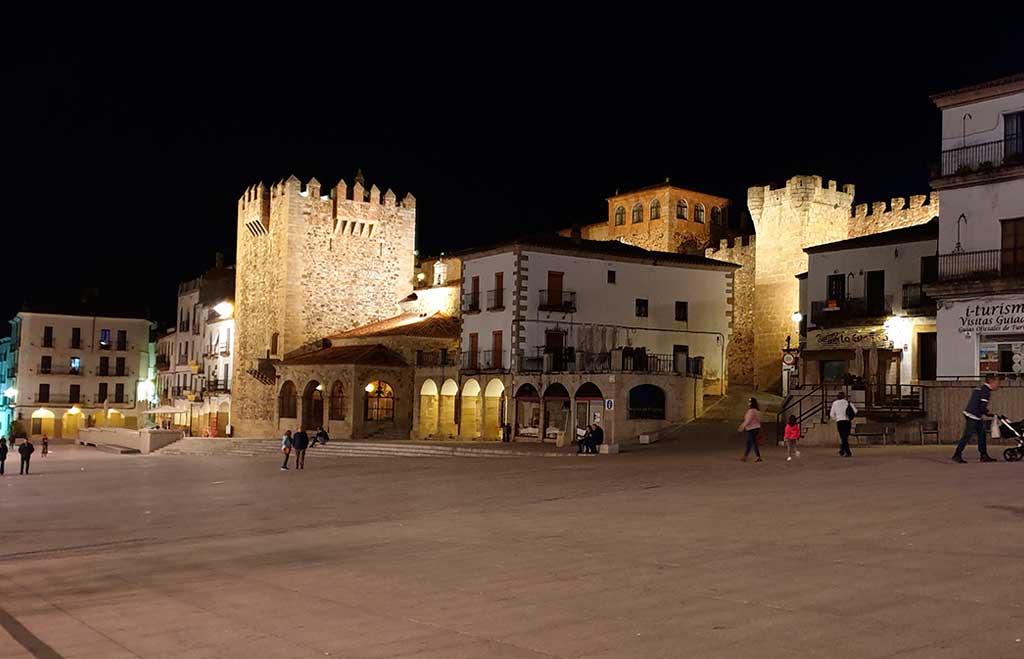Fall in love with the charm of rural village life
Architecture from pre-Roman times, the reign of the Roman Empire and the Medieval era is well-represented in Spain, both in former capital cities and also in small rural villages. Thankfully, many of these beautiful historic buildings have been wonderfully preserved, often due to having been abandoned when territorial development evolved in favor of other mainstream, more prosperous cities.
The majority of these constructions belong very dominantly to the Romanesque style, later evolving towards the Gothic. If this style interests you, you’ll be delighted to learn that some areas in Spain are known to treasure Romanesque items in a higher density than what is found anywhere else in Europe.
Fortuitously for Viabo Travel, the circuits that lead to these hidden gems are more often than not overlooked by visitors who only frequent the well-known iconic and densely populated tourist hotspots.
We’re passionate about giving our travelers a taste of the road less traveled, choosing instead to showcase and grant access to unusual and seldom-visited sites. Not only will you marvel at their uniqueness, but our learned professional lecturers will be by your side to reveal the historical events, meanings and hidden messages behind these culturally significant treasures.
For centuries, thousands of pilgrims have made the annual pilgrimage on St. James’ Way, finally reaching the capital of Galicia and entering via the iconic Cathedral.
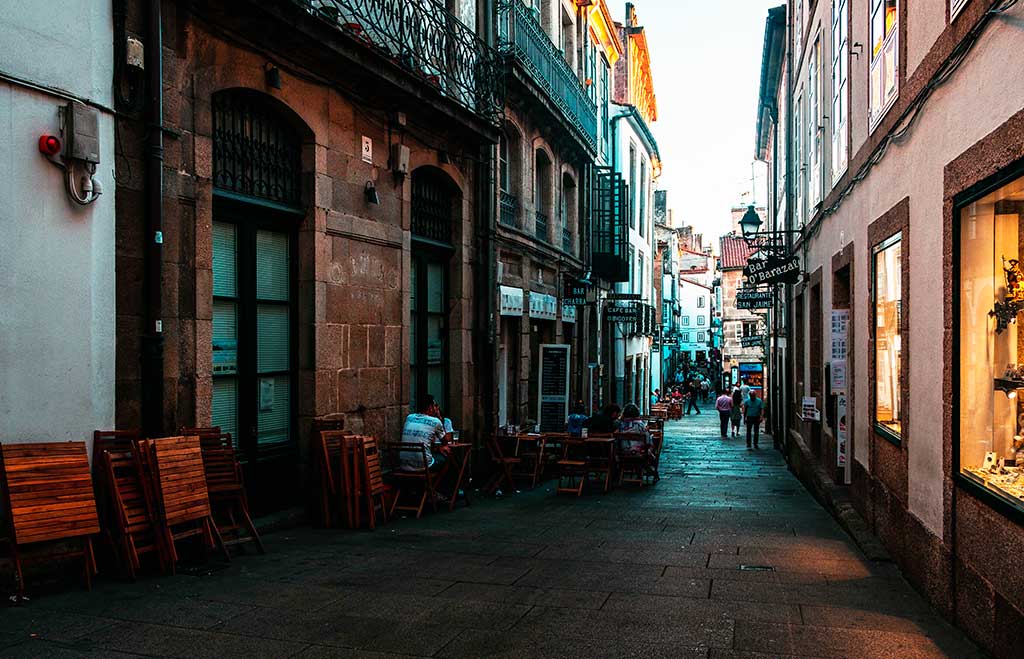
According to tradition, this is the burial place of the relics of James the Apostle, discovered in the 9th century.
Santiago de Compostela might be a celebrated burial place, but it is very much a living city today, with numerous attractions for travelers, whether pilgrims or not. There’s plenty to do, including frequenting restaurants and bars to enjoy Galicia’s delicious seafood, exploring the old town center (declared a UNESCO World Heritage site) and visiting the local galleries and enjoying their display of daring contemporary art.
The beauty of Santiago de Compostela is the way in which its ancient history is interweaved with its vibrant, young, modern side. The Old Town of Santiago de Compostela, together with the outlying Santa Maria de Conxo Monastery, constitutes an extraordinary ensemble of distinguished monuments.
The squares and narrow streets of the Old Town boast a beautiful variety of Romanesque, Gothic, Renaissance, Baroque, and Neoclassicist buildings. The town is not only a harmonious and well-preserved historical city, but also a place deeply imbued with faith. The cathedral, considered a masterpiece of Romanesque architecture, houses the remarkable Pórtico de la Gloria, a jewel of the medieval sculpture. Not to mention the authentic symbol of the city – the Baroque western façade of the cathedral, which forms one of the sides of the square of Obradoiro (considered to be one of the world´s most beautiful urban areas).
Sources:
https://www.santiagoturismo.com/rutas/a-rua-do-franco
https://www.pousadasdecompostela.com/en/blog/tapas-y-raciones-santiago-de-compostela
The city of Tui started off as a Roman settlement and was originally called ‘Tude’.
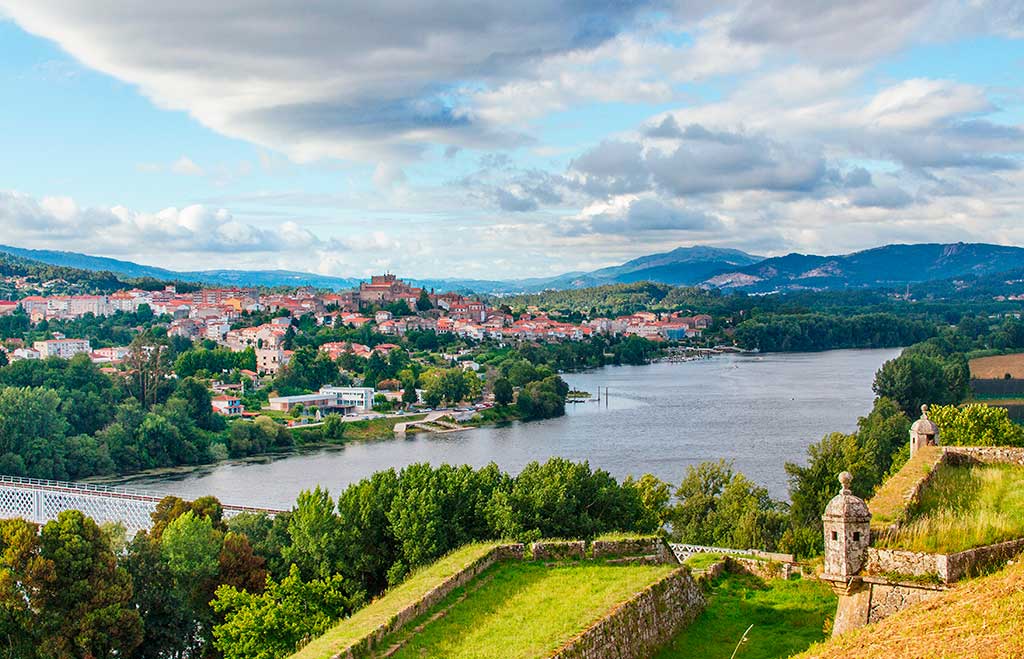
Due to the fact that parts of the original wall that first surrounded the city during the 12th century still stand today, it has been declared a Historic-Artistic Site.
Tui lies on the banks of the Miño River in northern Spain, right on the border of Portugal. In fact, the Portuguese town of Valenca lies directly opposite it on the other side of the river. Both towns are connected by a beautiful 19th century bridge.
Tui has a compact historic quarter with a number of important monuments. One of the most important is the castle Cathedral, which took over a century to complete. It was eventually consecrated in 1225 during King Alfonso’s reign.
Once inside visitors understand why it’s called a ‘castle’ Cathedral, with its impressive battlements and fortifications. The sheer scale of the structure is incredible, and that’s before one has stepped onto the cathedral’s viewing point, which boasts picturesque views across the water to Valenca and Portugal.
It’s a delight to wander through the narrow streets of Tui and explore the main square, which is lined with attractive Galician style buildings and outdoor cafes. Should you want a breath of fresh air thereafter, the nearby mountain of Aloia (the first place in Galicia to be declared a Nature Reserve) is well worth a visit as well.
Sources:
http://www.spainisculture.com/en/destinos/tui.html
http://www.vvww.net/articles/tuispain.html#:~:text=Tui%20started%20off%20as%20a,the%2012th%20century%20still%20standing
http://www.galiciaguide.com/Tui.html
The historic center of Valladolid, the city on the Pisuerga River, is home to an interesting collection of Renaissance architecture, from houses, palaces and emblematic buildings to the College of San Gregorio (today the site of the National Sculpture Museum) and the church of San Pablo.
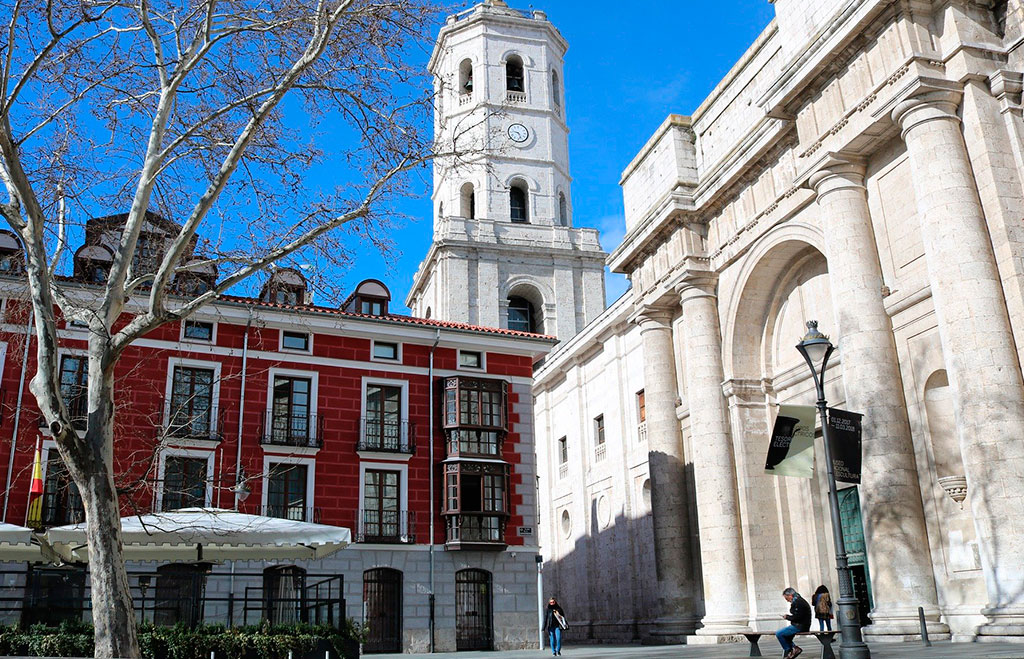
One particular architectural highlight is the unfinished cathedral. The original design for the project was commissioned by King Philip II from the architect Juan de Herrera in the 16th century. Both men died before the cathedral’s competition, however, and its central section was not opened until 1668.
Years later, in 1730, the Master Churriguera completed the work on the main facade. Inside the cathedral, the main chapel houses a magnificent altarpiece produced by Juan de Juni in 1562. The space also includes the Diocesan Museum, containing a number of carved images attributed to Gregorio Fernández and to Juni himself, in addition to a silver monstrance by Juan de Arfe.
Other religious buildings of interest are the Gothic church of Santiago, and the church of Santa María la Antigua, with its unusual Romanesque tower crowned with a pyramid. Valladolid’s University building is equally noteworthy, boasting a Baroque façade decorated with various academic symbols, as is Santa Cruz College, one of the earliest examples of the Spanish Renaissance.
The homes of important historical figures can still be seen throughout the city, including the House of Cervantes, where the author of Don Quixote lived with his family between 1603 and 1606.
Salamanca is an ancient university town situated in the west of Spain in the autonomous community of Castile and León. The Carthaginians first conquered the city in the 3rd century BC.
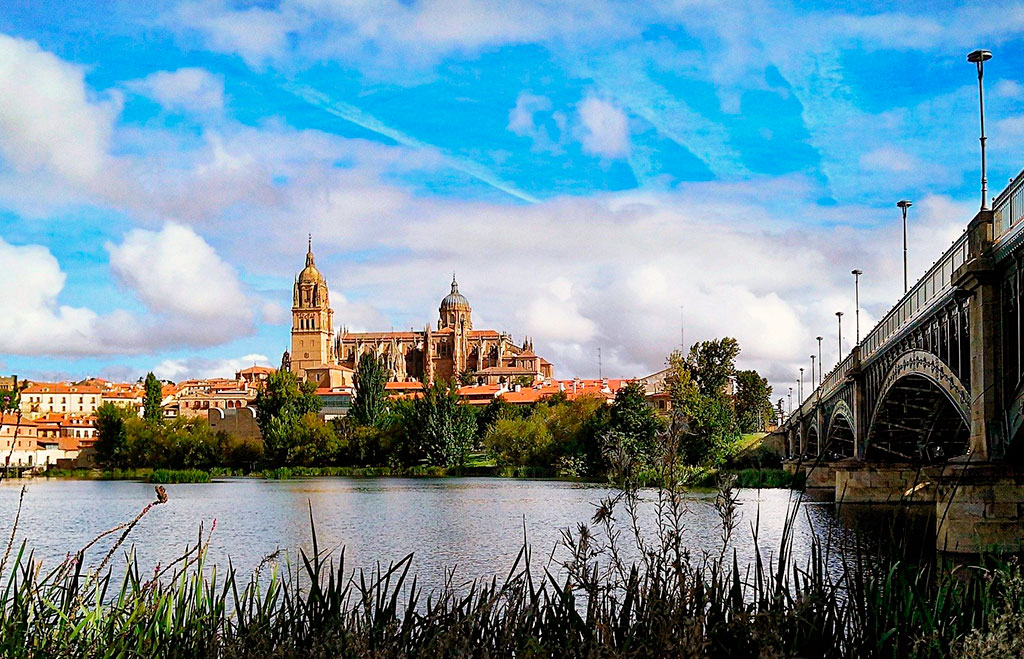
It then became a Roman settlement before being ruled by the Moors until the 11th century. The city’s historic center has important Romanesque, Gothic, Moorish, Renaissance, and Baroque monuments, and has been designated a UNESCO World Heritage Site as a result.
There are numerous architectural sights to behold in Salamanca, but the city owes its most essential features to the University. It is one of the oldest in Europe, reaching its high point during Salamanca’s Golden Age, and is comprised of a remarkable group of buildings in Gothic, Renaissance, and Baroque styles. Without a doubt, it’s an exceptional example of an old university town in the Christian world, along the same prestigious lines as Oxford and Cambridge.
There are other must-see sights situated both in the Old Quarter of the city and also in the surroundings of the protected core area. All are magnificent examples of religious architecture belonging to different styles: the Romanesque churches of San Marcos, San Juan de Barbalos, and San Cristóbal; the convents of Las Claras and Santa Teresa; the Gothic-Renaissance church of Sancti Spiritus; and the Colegio de los Irlandeses.
If you’re visiting this pretty location, you might as well view it as it best. Locals advise experiencing Salamanca at dusk, when the sun gives a golden hue to the material used in the construction of Salamanca’s monuments: Villamayor stone.
The picturesque town of Peñafiel is one for the books. Its historic center has been declared a place of Cultural Interest and its famous castle, declared a National Monument in 1917, sits dramatically on top of a hill overlooking the town.
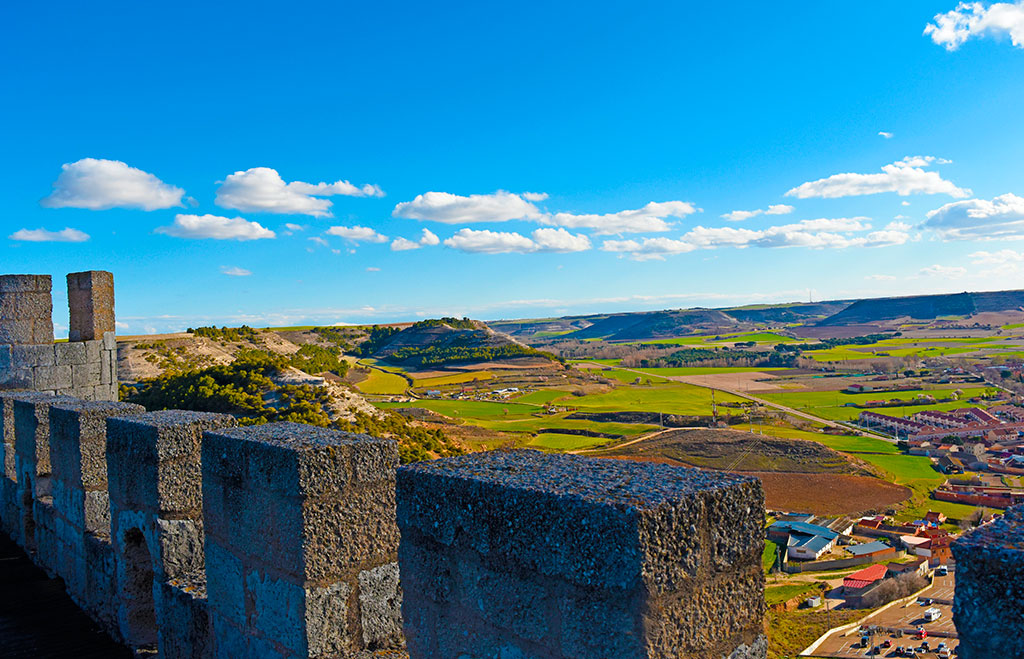
The castle’s current appearance is the result of a combination of several structures, the first from around the 9th century, and the last from the mid-15th century. It is a very well-preserved fortress, built in the shape of ship. The keep, more than 30 meters high, is flanked by two courtyards: one to the north, which contains the underground reservoirs and the store rooms, and one to the south, which was originally the site of the stables and guards’ quarters but today houses the Provincial Wine Museum.
The Provincial Wine Museum is one of the most visited museums in Castile and León (averaging 100 000 visitors a year) and its success is divided between its beauty and the cultural value of both the content and the building itself. It has been, deservedly, called a ‘place of pilgrimage’ for lovers of cultural and wine tourism and is not to be missed.
Other than the castle, the most important building to visit in Peñafiel is the church of San Pablo. It was founded in 1324 and is one of the finest examples of the Valladolid region’s Gothic-Mudejar architecture, visible in the outside treatment of the brick chevet, buttressed by two protruding towers above horseshoe arches.
Sources:
http://www.spainisculture.com/en/destinos/penafiel.html
http://www.turismopenafiel.com/recurso.php?m=3&nv=0&id=208&lang=en
https://www.rutadelvinoriberadelduero.es/en/accessible-cultural-resource-monument-castle-museums-and-interpretation-centres/museo-provincial-del
https://travelguide.michelin.com/europe/spain/castile-and-leon/valladolid/penafiel/church-san-pablo
Segovia is located in the center of Spain in the autonomous community of Castile and León.
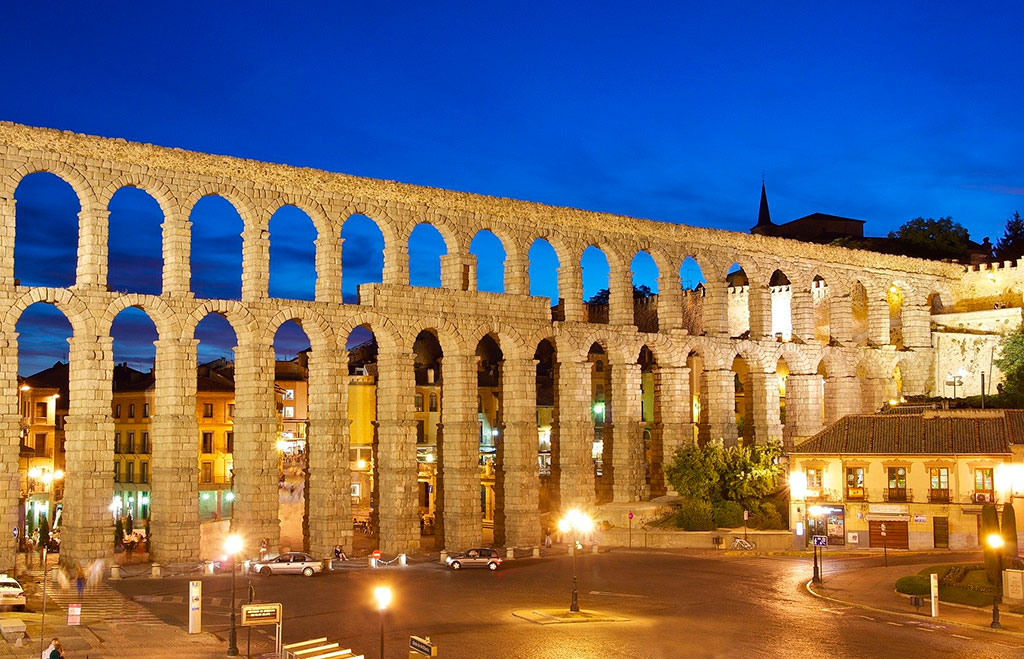
The beautiful old town lies on high ground between the Eresma and Clamores Rivers and its Old Quarter and Roman aqueduct have been declared UNESCO World Heritage Sites.
The Roman aqueduct’s highest point is displayed in Azoguejo Square. It is here where two monumental stone block rows, held up by an impressive 167 arches, become the symbol of the city, serving as the main entrance to Segovia’s historic quarter. This engineering gem, still beautifully preserved today, was built under the Roman Empire (1st century AD). It served to carry water to the elevated city from up to 15 km away. Its 163 arches (standing 29 meters tall at their highest points) are supported by blocks of stone from the Sierra de Guadarrama mountains (completely plaster, lead and mortar-free).
In addition to its famous aqueduct, numerous Romanesque churches, the Alcázar fortress, noble palaces from 15th and 16th centuries, the 16th century Gothic cathedral (the last to be built in Spain in this style), the Alhóndiga (the old Gothic cereals exchange), the Torreón de Los Lozoya Tower (originally a 14th century defensive structure) and the Segovia Mint (the oldest industrial building still existing in Spain) serve to form the magnificent landscape that presides over this part of Castile.
Visitors love Segovia for the fact that it is symbolic of a complex, historical reality. Its neighborhoods, streets, and houses are laid out in accordance with a social structure in which hierarchy was organized and dominated by belonging to one of the different cultural communities. Moors, Christians, and Jews coexisted for a long period of time in the medieval city. Having been a trading center under the Roman Empire, Segovia reached its period of greatest splendor during the Middle Ages. It was during this period that a great many of the local Romanesque buildings were built, a rich heritage preserved for us to enjoy today.
Sources:
https://whc.unesco.org/en/list/311/
http://www.spainisculture.com/en/destinos/segovia.html
https://www.360cities.net/image/roman-aqueduct-from-azoguejo-square-segovia-spain
The picturesque old town of Avila and the churches outside the city walls have been declared of Cultural Interest and a UNESCO World Heritage Site.
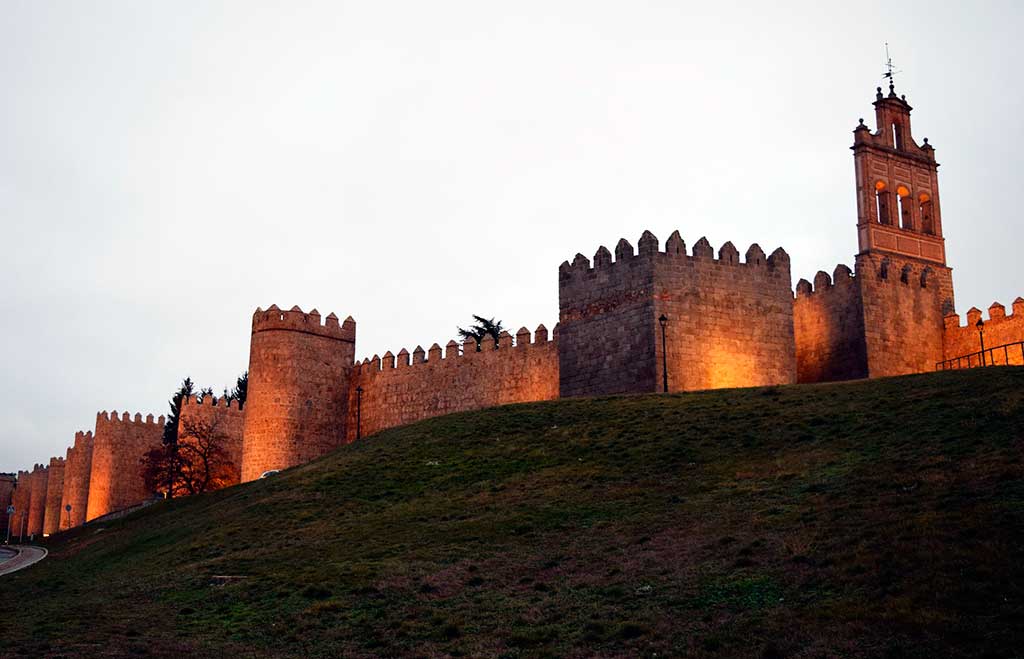
Being the birthplace of Saint Teresa of Jesus has left its mark across the city, with a large number of religious buildings linked to the saint’s life.
The peak period of the city was in the 16th century when wool manufacture ensured its economic take-off. During this boom, many civil and religious buildings were built, a lot of which still stand in the historic quarter today.
Valuable churches and Renaissance palaces still bear witness to the town’s past wealth as a textile center today. These include four extra-muros Romanesque churches (San Segundo, San Andrés, San Vicente, and San Pedro), another three Romanesque churches (San Nicolás, Santa María de la Cabeza, and San Martín) and three convents from the 15th and 16th centuries (La Encarnación, San José and the Real Monasterio de Santo Tomás).
There’s no doubt that the ‘City of Saints and Stones’ has maintained its medieval austerity, the best example of which is the Gothic cathedral and its numerous fortifications that, with their 87 semi-circular towers and nine gates, are arguably the most complete found in Spain.
There are a multitude of architectural wonders to behold in Avila, but if too much touring leaves you fatigued, be sure to stop and indulge in the town’s excellent roasts, well-known Avila veal cutlets and Saint Teresa’s famous dessert – ‘yemas’ (sugared egg yolks).
Sources:
https://whc.unesco.org/en/list/348/
http://www.spainisculture.com/en/destinos/avila.html
León is the capital of the province of León, located in the northwest of Spain.
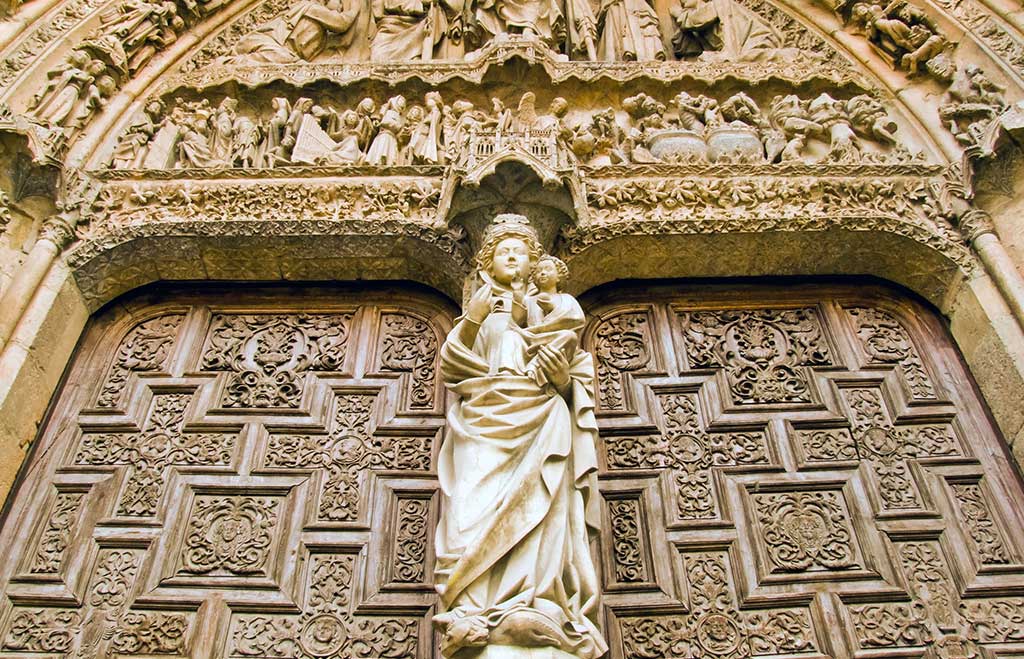
It was first founded in the 1st century BC by the Roman legion Legio VI Victrix, established to protect the recently conquered surrounding territories and to secure the transport of gold extracted in the province.
The city retains an interesting Romanesque, Gothic and Renaissance legacy, the result of its splendor during the Middle Ages. In the area surrounding the city walls, there are two jewels (located at either ends of each other) that are a must-see for travelers: The Santa María de León Cathedral (also called ‘The House of Light’ or the ‘Pulchra Leonina’ Cathedral) and the Basilica of San Isidoro.
The Pulcra Leonina is one of the most striking Gothic temples in Spain. Approaching it face-on offers travelers a view of one of the most significant series of Gothic sculptures and an awe-inspiring 1 800 square meters of stained-glass windows.
The Basilica de San Isidoro, on the other end, is one of the most significant sites in the whole of Europe, proudly referred to as the “Sistine Chapel” of the Spanish Romanesque style. This site is celebrated for many architectural, historical and artistic wonders, one of which is a beautiful series of frescoes from the 12th century which decorate the underground crypt of the Royal Pantheon. It is also the resting place of León’s medieval monarchs.
León’s historical and architectural heritage, as well as the numerous festivals hosted throughout the year, and its location on the French Way of the Camino de Santiago, make it a destination well worth visiting.
Sources:
http://www.spainisculture.com/en/destinos/leon.html
https://en.wikipedia.org/wiki/Le%C3%B3n,_Spain
https://en.wikipedia.org/wiki/Le%C3%B3n_Cathedral
Burgos, a city in Castilla-Leon situated on the Pilgrim’s Road to Santiago de Compostela, still preserves important vestiges of its medieval splendor.
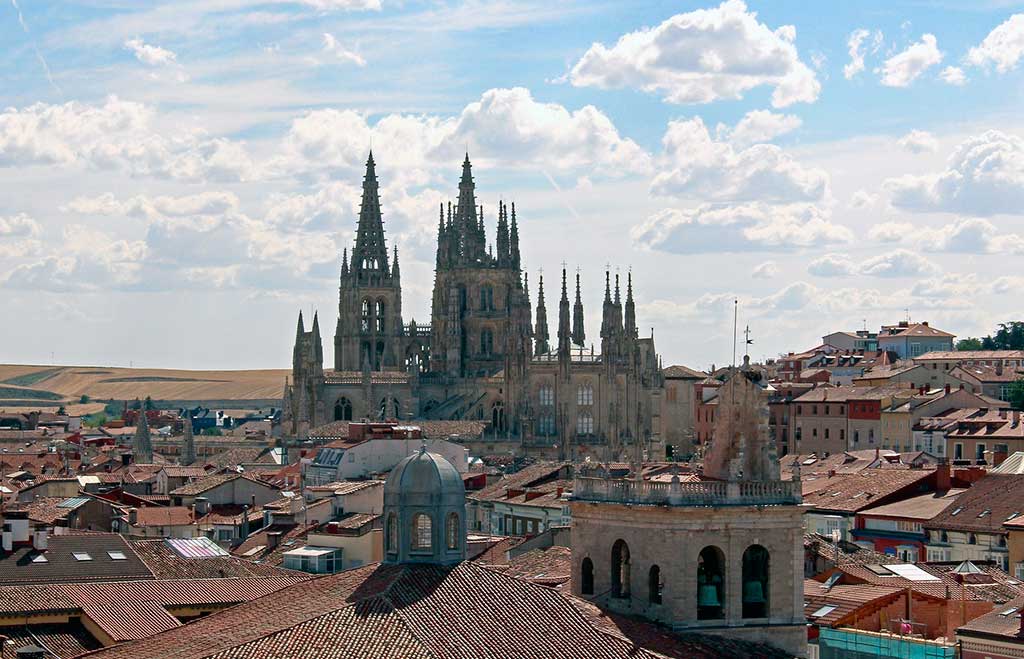
The city was the capital of the unified kingdom of Castilla-Leon for 5 centuries and boasts the Burgos cathedral – a masterpiece of Spanish Gothic architecture.
The cathedral, declared a UNESCO World Heritage Site, is erected on top of a Romanesque temple and was built following a Norman-French Gothic model. The filigree work in the spires of the towers and in the exterior of the High Constable Chapel are just some of the masterpieces found in this cathedral. Such beauty and incredible genius lead to a long list of exceptional works of art in its interior. These include the starry dome that covers the tombs of El Cid and Doña Jimena, the choir, the sarcophagi and the Golden Staircase, built by Spanish architect and sculptor Diego de Siloé, a prominent figure during the Spanish Renaissance.
Before the Romans definitively stamped their mark on history in the territory of Burgos, however, there were already signs of life from prehistoric man in the area, as has been highlighted in the important modern-day discoveries made in Ojo Guareña and Atapuerca (just a few kilometers from the city), where one of the most important archaeological sites in the world is currently being safeguarded for the study of human evolution.
Sources:
https://www.turismocastillayleon.com/en/art-culture-heritage/provincial-capitals/burgos
http://www.spainisculture.com/en/destinos/burgos.html
Tordesillas is a former defensive bastion against Muslim invasion.
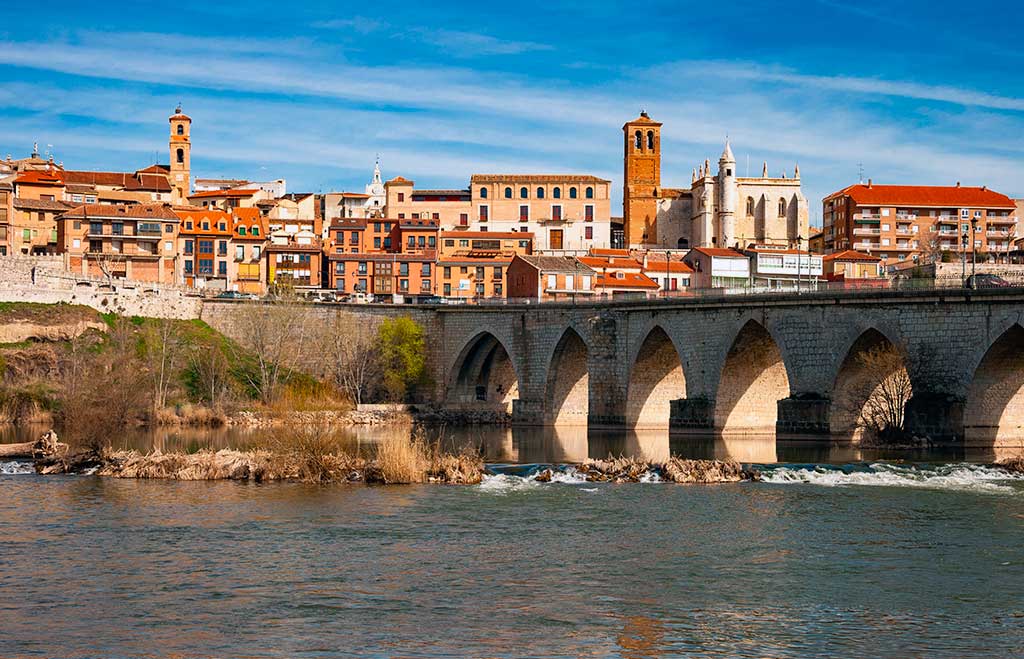
Its most representative building is the Royal Monastery of Santa Clara. The building first existed as a palace built by King Alfonso XI in 1350, but it was later converted into a convent by his son, Pedro I the Cruel.
Santa Clara, declared a site of Cultural Interest in 1931, stands out because of its façade in the Almohad style, its Arabic baths and the reredos in the exceptional chapel of Saldaña. All the rooms contain elements of great architectural and decorative interest, including a curious portable reredos and a clavichord which belonged to Juana la Loca.
Also outstanding among the ecclesiastical buildings in Tordesillas is:
- The church-museum of San Antolín, declared to be a site of Cultural Interest in 1998. Its main feature is a 16th century reredos with sculptures by Juan de Juni, standing in the chapel of Alderete.
- The church of Santa María, a Gothic structure which was remodeled in the 16th century in the style of El Escorial.
Other points of interest in the town are the adjoining palaces, the Casas del Tratado, the main square, a medieval bridge of 10 arches and some remains of the wall which surrounded the entire town.
Source:
https://www.spain.info/en/que-quieres/ciudades-pueblos/otros-destinos/tordesillas.html
Trujillo is a beautiful old city in western Spain where the legacy of Romans, Visigoths, Muslims, Jews and Christians is clearly visible.
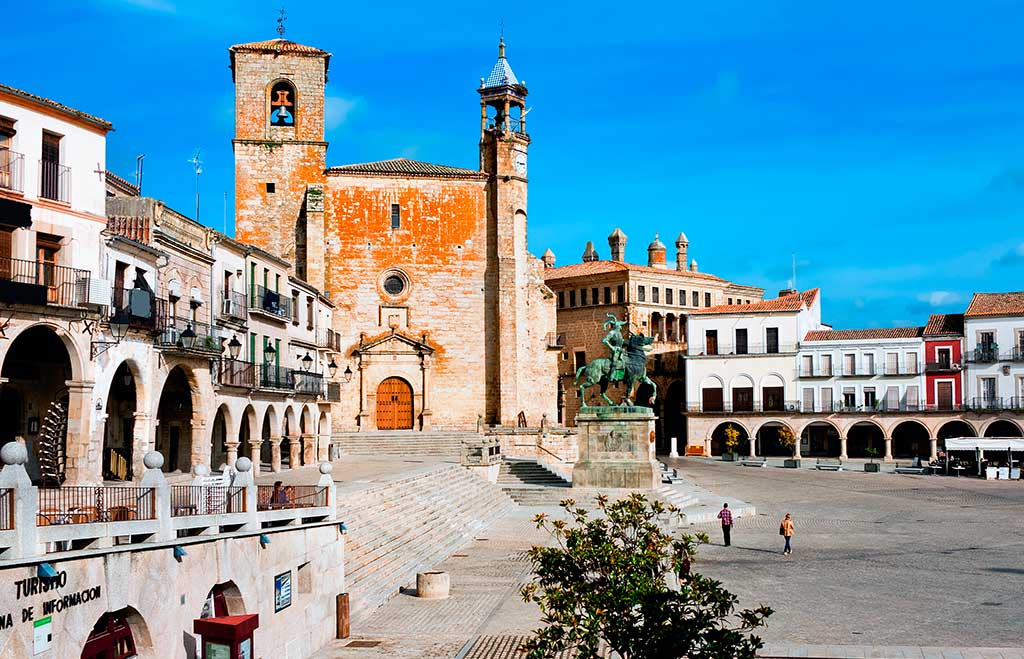
It boasts a majestic Castillo, a medieval stone fortress, sitting atop a hill overlooking the town center. The town is typically structured around a monumental main square, the Plaza Mayor, encompassed by magnificent palacial architecture.
Besides a visit to the city’s castle, there are numerous churches in Trujillo for travelers to admire, two of which are:
- The church of San Martín, built between the 14th and 16th century. It stands prominently in the town square, showing off beautiful Gothic architectural features on the exterior and several Renaissance side-chapels in the interior.
- The church of Santa María la Mayor, situated in the historic quarter, which is considered to be one of the most beautiful examples of Romanesque art in Trujillo. Only the eastern tower, called the Julia Tower, remains of this original church (which dates back to the 13th century). A central nave and two side naves were added in the 14th century. Later, in the 16th century, new ribbed vaults, a new tower, and a baptistry were commissioned. The paintings around the main alterpiece on the inside are beautiful examples of the work created by the masters Fernando Gallego and Bartolomé in around 1490. These alone are worth the visit, as many experts agree that these are of the best examples in the whole of Extremadura.
Source:
http://www.spainisculture.com/en/destinos/trujillo.html
https://www.turismoextremadura.com/en/explora/Trujillo-00001/
The city of Cáceres’s history of battles between Moors and Christians is prominently reflected in its architecture, which is a blend of Roman, Islamic, Northern Gothic and Italian Renaissance styles.
Cobbled streets, marked out by medieval house-fortresses and Renaissance palaces, are some of the typical scenes to admire in this city. Not surprisingly, the old town has been declared a UNESCO World Heritage site.
Since prehistoric times, people from different cultures have gathered in Cáceres and shaped its strong historical roots. Pre-Roman settlements occupied the area originally, followed by the Roman, Arab, Jewish and Christian people.
Cáceres has been a trade route city and a political centre of the local nobles for many centuries. Its history is closely linked to one of the historic routes on the peninsula, the Silver Route. This refers to the old Roman road that joined Seville and Astorga, later used by the pilgrims as they made their way to Santiago de Compostela. Excellent pork products and recipes based on typical shepherd’s dishes are the basis of the region’s rich culinary traditions.
The city paints a beautiful picture and presents numerous noteworthy religious buildings (churches, hermitages and convents) for travelers with a cultural and architectural interest to admire.
Source:
http://www.spainisculture.com/en/destinos/caceres.html, https://whc.unesco.org/en/list/384/

